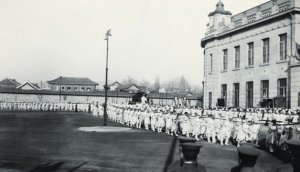Presented By: Nam Center for Korean Studies
Nam Center Colloquium Series | Writing History Through Photography: Kojong's Funeral of 1919
Se-Mi Oh, Assistant Professor, Department of Asian languages and Cultures, University of Michigan

Co-sponsored by the Department of Asian Languages & Cultures.
This presentation looks into Kojong’s funeral in 1919, which became a backdrop for the March First Movement. While thousands of people took to the streets in display of modern public awareness and in demand of national independence, the event took place alongside the carefully-orchestrated funeral procession of the late king Kojong by the Japanese colonial government. This presentation asks how the funeral was re-staged as a modern spectacle and how it was subsequently narrated through photography (and cinema). At the crux of my analysis are the ways in which an age-old monarchical pageantry became an instrument for the narrative strategy of modern history. When a funeral procession was the dead’s journey to a holy place, making the place of the dead relevant in history through the sacrialization by ritual, the eternality of history was turned into the virtual, memory, and nostalgia by photography. I compare this photographic narrative to Ûigwe (The Records of Rites and Ceremonies) of the Chosôn dynasty, and discuss how the depiction of ritual -- repetitive and ephemeral -- became the singularity of event in the freeze frame of photography and in the linear narrative of panoramic cinema.
Se-Mi Oh is an Assistant Professor of Modern Korean History in the Department of Asian Languages and Cultures. Her current research focuses on the architectural and urban practices of Colonial Seoul of the 1920s and 1930s. Her book manuscript entitled Seoul Streets: Surface Matters and Speech Matters examines the relationship between language, text, and media in tracing the discursive formation of modernity and colonialism in Korea through urban space.
This presentation looks into Kojong’s funeral in 1919, which became a backdrop for the March First Movement. While thousands of people took to the streets in display of modern public awareness and in demand of national independence, the event took place alongside the carefully-orchestrated funeral procession of the late king Kojong by the Japanese colonial government. This presentation asks how the funeral was re-staged as a modern spectacle and how it was subsequently narrated through photography (and cinema). At the crux of my analysis are the ways in which an age-old monarchical pageantry became an instrument for the narrative strategy of modern history. When a funeral procession was the dead’s journey to a holy place, making the place of the dead relevant in history through the sacrialization by ritual, the eternality of history was turned into the virtual, memory, and nostalgia by photography. I compare this photographic narrative to Ûigwe (The Records of Rites and Ceremonies) of the Chosôn dynasty, and discuss how the depiction of ritual -- repetitive and ephemeral -- became the singularity of event in the freeze frame of photography and in the linear narrative of panoramic cinema.
Se-Mi Oh is an Assistant Professor of Modern Korean History in the Department of Asian Languages and Cultures. Her current research focuses on the architectural and urban practices of Colonial Seoul of the 1920s and 1930s. Her book manuscript entitled Seoul Streets: Surface Matters and Speech Matters examines the relationship between language, text, and media in tracing the discursive formation of modernity and colonialism in Korea through urban space.